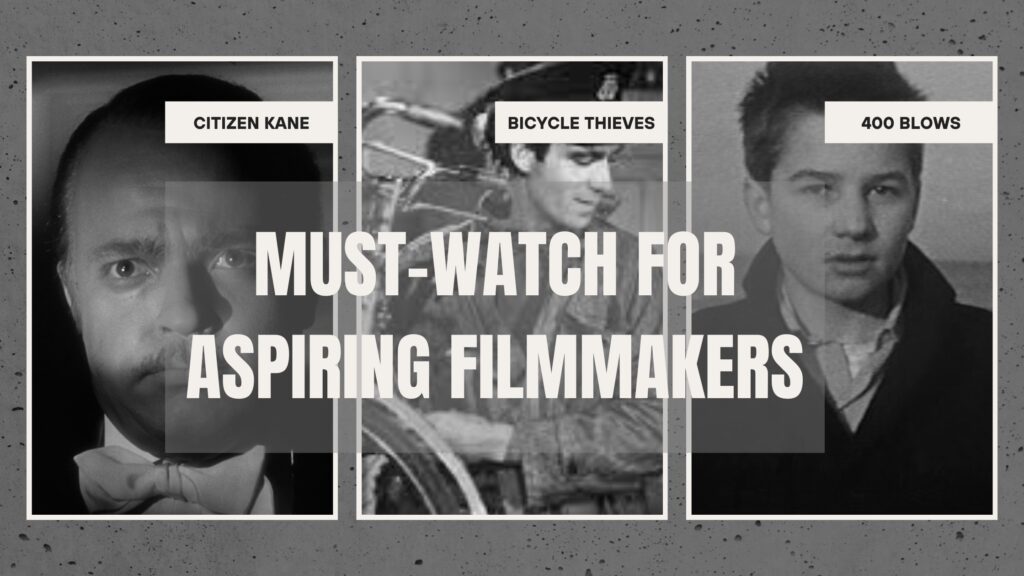One’s pursuit of mastering the art of filmmaking should begin with watching cinematic masterpieces across the world. Learn from established directors, writers, and cinematographers through their work. Their body of work not only delivers entertainment but also invaluable lessons you can apply to your work.
In this article, we dive into three must-watch films every aspiring filmmaker should add to their watchlist. Join Phantom Filmmaker in uncovering the key insights into some of the most remarkable films ever made. Discover more about these magnificent films below:
Citizen Kane
Year released: 1941
Director: Orson Welles
Screenwriter/s: Herman J. Mankiewicz and Orson Welles
Cinematography: Gregg Toland
Runtime: 119 minutes
Main cast: Orson Welles, Joseph Cotten, Dorothy Comingore, Everett Sloane
What is the Citizen Kane movie about?
Citizen Kane 1941 follows Charles Foster Kane (Welles), a newspaper magnate whose last word, ‘Rosebud’ kickstarts the exploration of his life and legacy. Throughout the film, we witness Kane’s rise as a wealthy newspaper tycoon, his failed marriages, and his eventual isolation from the rest of the world.
The film is shown through the perspective of various people who encountered Kane throughout his life, including friends, journalists, and associates.
What you can learn from Citizen Kane:
When it comes to must-watch films for aspiring filmmakers, Citizen Kane is almost always part of the list, and for good reason. It explores complex themes and offers the audience a compelling narrative focused on the elusive nature of truth, the influence of power, and more.
As an aspiring filmmaker, here are the biggest takeaways you can gain from the film:
The use of visual symbolism
The cinematography and symbolic imagery in Citizen Kane immediately stand out. When watching the film, analyze how these exemplary visual elements elevate the rich narrative and the audience’s emotional journey.
Storytelling technique
If you want to explore different storytelling techniques beyond the three-act structure, then Citizen Kane is the best film to watch. It follows a non-linear narrative from multiple perspectives. This stylistic choice adds to the complex narrative, keeping audiences engaged.
The 400 blows
Year released: 1959
Director: François Truffaut
Screenwriter/s: François Truffaut and Marcel Moussy
Cinematography: Henri Decaë
Runtime: 99 minutes
Main cast: Jean-Pierre Léaud, Albert Rémy, Claire Maurier
What is 400 Blows about?
400 Blows, known in French as Les Quatre Cents Coups, is a French New Wave masterpiece created in 1959. It’s a coming-of-age film centered on Antoine, a young boy in Paris facing challenges with a dysfunctional family dynamic, the hardships of adolescence, and societal expectations.
What you can learn from it:
The 400 Blows takes a heavy inspiration from Truffaut’s troubled childhood experience. His infusion of fiction with his personal experience delivers one of the most authentic and honest films with compelling and relatable characters.
Here are some of the biggest filmmaking lessons you can take away from the film:
Cinematography’s influence on the storytelling
400 Blows is a character-driven film told through Antoine’s perspective. The cinematography lends itself to driving the emotion of each scene through its natural lighting, handheld camera movements, and intimate framing.
Social commentary
The film is set against the backdrop of post-war Parisian society and discusses themes of dysfunctional family structures, juvenile delinquency, and rigid educational systems. Take a page out of Truffaut’s book when discussing various societal issues to deliver a poignant narrative that can provoke meaningful discussion.
Bicycle thieves
Year released: 1948
Director: Vittorio De Sica
Screenwriter/s: Oreste Biancoli, Suso D’Amico, Vittorio De Sica, Adolfo Franci, Gherardo Gherardi, Gerardo Guerrieri, and Cesare Zavattini.
Cinematography: Carlo Montuori
Runtime: 89 minutes
Main cast: Lamberto Maggiorani, Enzo Staiola, and Lianella Carrell
What is the film about?
Bicycle Thieves, also known as Ladri di Biciclette, is an Italian neorealist film by Vittorio De Sica. It focuses on Antonio Ricci, an unemployed father post-World War II. At the start of the film, he scores a job to hang posters around his city. Unfortunately, his bicycle, which he needs for his work, is stolen during his first day of work. Thus begins his search for it through the streets of Rome with his son, Bruno.
What you can learn from it:
Though the film’s basic summary may seem too simplistic, the emotional journey Bicycle Thieves takes its audience on is anything but. Here are some of the biggest factors you can learn through this film:
Dedication to realism
Vittorio De Sica’s unfailing commitment to depict the post-war state of Italy through the Bicycle Thieves results in an authentic and emotional narrative. Through the film, you can learn how to capture social issues on a visceral level that can evoke meaningful conversation from your audience.
Learn from the pros: Start your filmmaking journey with superb films
The three films we’ve covered are only some of the many cinematic masterpieces you can watch as an aspiring filmmaker. Starting with these three can offer you insight into the importance of visual expression, meaningful storytelling, and more. These exemplary works can help shape your growth as a filmmaker and gain crucial skills in the art of visual storytelling

For further reading